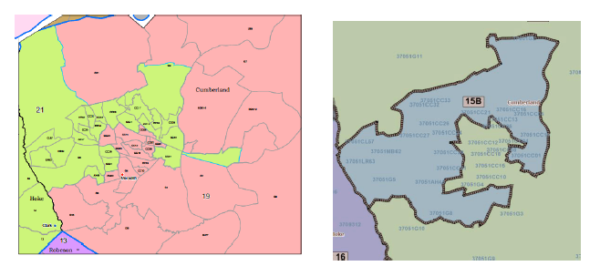DURHAM, N.C. – A white paper released today by the Southern Coalition for Social Justice documents some of the racial and partisan biases infecting the most recent judicial redistricting plan presented by a state legislative committee. Draft judicial districts unveiled in the December meeting of the Senate Select Committee on Judicial Reform and Redistricting covered many of the same geographic areas as legislative districts found to be unconstitutional racial gerrymanders in some places and are likely to lead to an enormously disproportionate number of Republican judges being elected throughout the state.
“If enacted, the most recent judicial redistricting proposal would create layers upon layers of unconstitutionality in our judicial system,” said Allison Riggs, senior voting rights attorney for the Southern Coalition for Social Justice and author of the white paper. “Huge variation in the number of residents per judges across our state, with a consistent pattern of too many people per judge in our urban areas will likely result in people of color disproportionately having less access to our justice system.”
The full judicial redistricting analysis can be found at http://bit.ly/JudicialRedistricting
The analysis also highlights strong evidence of racial and partisan gerrymandering. Many of the districts in the proposal look strikingly similar to districts unanimously invalidated or under continued scrutiny as racial gerrymanders from federal courts. Specifically, districts in Cumberland and Guilford counties appear to pack African-American residents into districts with fewer resources. The result is unfair lack of access to judicial resources for those communities amounting to second-class justice.
“The most recent judicial redistricting plan represents a gross political gerrymander, designed to ensure that Republican judges will be elected in a disproportionate number of districts statewide. This is even more concerning given the recent decision by a federal court that found North Carolina’s congressional district plan to be unconstitutional partisan gerrymanders,” added Riggs. “Taken together, these constitutional flaws will almost certainly create second-class justice for people of color and the people who choose to associate with the political party not in power. Neither is an appropriate element in structuring an independent and fair judiciary.”
According to the analysis, Republican judges would be expected to win 70 – 72% of Superior Court races, 69.4 – 71 % under the most recent plan put forth in the legislative committee.
The report also highlights population deviations in the judicial redistricting plan that dilute the voting strength of some North Carolinians while advantaging others, as well as analysis of the disproportionate pairing of judges who are African-American and/or registered Democrats.
“While it’s true that the legislature has been working on judicial redistricting for months, albeit in a completely non-transparent manner, the current plan is something that the public has only seen for three weeks over the holidays. The impacts of shifting court resources and apportioning voters per judges is something that changes with each update or version of the redistricting proposal,” added Riggs. “North Carolinians need time to figure out what each change means for important legal services in the community – such as drug courts, guardian ad litem programs, and so much more. Anyone acting in good faith should know that and should want meaningful input from affected judges and voters. We need a more thoughtful and inclusive process.”
“The one thing that’s clear from the most recent plan, though, is that it for Democrats and North Carolinians of color a system in which they will receive second-class justice. That is unacceptable,” concluded Riggs.
The full judicial redistricting analysis can be found at http://bit.ly/JudicialRedistricting
Analysis of N.C. Judicial Redistricting Proposal Finds Racial and Partisan Biases
Voting Rights

